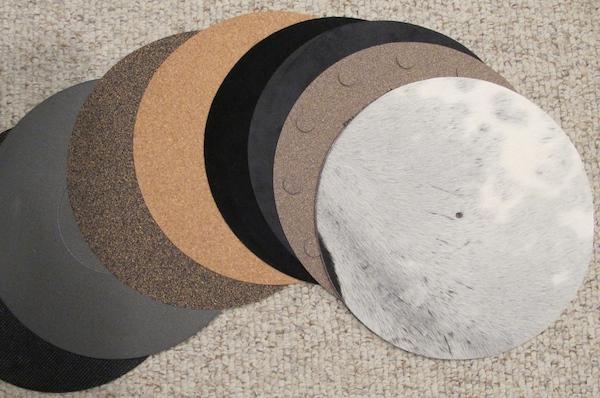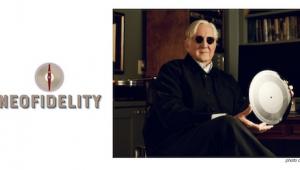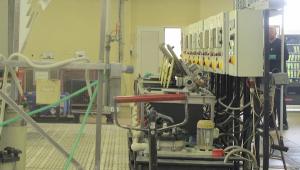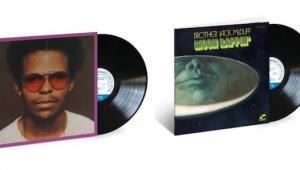I am not sure my old ears are up to this, but the exercises are fun. If I fail this test I may have to go outside and "clap erasers" like in elementary school. Yes chalk, accept no substitutes. All this technology in school has not made us smarter, but I digress. OK. Rollem'.
Man (Or Woman) Enough For a Blind Mat Test?

Using the same track from Mike Valentine's Chasing the Dragon audiophile demo record (an excerpt of Vivaldi's "Concerto For Two Mandolins") recorded utilizing a "Decca Tree" microphone array, I recorded to 44.1k/16bit WAVE files 8 (count them) mats, on the recently reviewed Zorin Audio turntable and tonearm. The cartridge was a Lyra Titan i feeding a Swan Song Audio Cygnet MC phono preamplifier, the review of which is almost finished.
The mats were: 1) the stock carbon fiber one supplied with the Zorin 2) a Boston Audio Graphite mat 3) "The Simple Mat" made from synthetic cork 4) a now discontinued one of what feels like ultra-thin 1/16th of an inch cork from a fellow who shall remain nameless and whose mat was nameless so I'll call it the Brooklyn mat 5) the Hideinthesound suede mat 6) the Hideinthesound split mat with suede on one side and a smooth hide on the other side, 7) The Music Hall cork mat 8) the Moo mat made of cow hair and hide.
Once these files are posted, you can download them, listen to decide if you can or cannot hear differences and if so, which one you prefer. You can only vote for one, so in the comments section say why and add others if you think they too sounded better than the others.
Or, maintain your sanity and don't bother listening. I will post my thoughts on the various mats while the voting occurs. And the record will be reviewed soon too.
- Log in or register to post comments


No AudioQuest Sorbothane or Discwasher felt mats?
What about the foam one from an old AR?
Cut your own out of the black Con-Tact Grip Premium material:
http://www.contactbrand.com/shop-grip-premium.htm

Nevertheles, it might be interesting to include one in the test to hear how a mat with those properties actually sounds in comparison to mats made of the other materials.
Did you ever try one with a peripheral clamp, such as the one from VPI?

Sorry, the use of a center spindle weight or clamp was just assumed.

I always thought you selected components and accessories to fit the system, so even if we have a clear winner here, it might not be the best in every system.... I have the music hall mat, and use it specifically in my cheapo 90s vintage p-mount Denon in my bedroom, because I trusted the company's claims that the raised cork discs on the mat helped "decouple it from the platter", which I thought would be a good thing for an old direct drive system, and, indeed, it sounds improved over the stock rubber mat. On my VPI classic one, however, it does not improve the sound... Waiting to get a carbon fiber mat for that table....

If the mats you're comparing aren't of the same thickness, then you need to (re)adjust the VTA to compensate. Otherwise you're changing more than one variable in the test.

Good to know how much change in VTA-SRA is considered audible. There was an article on the Absolute Sound site where they seem to be trying to set VTA-SRA with a precision of up to 3 decimal places.

The results of changing the arm pivot height 4 mm has nothing to do with the results of changing heights at the stylus. Angles are calculated using trigonometry and trigonometry is all about ratios, not absolute amounts. 4mm is a small percentage of the record to pivot height so, yes, there is a small change in angle. On the other hand, at the stylus tip 4mm represents a very large percentage change.
In the linked article Geoff Husband calculates that with a typical cartridge a height change of .035mm at the stylus results in a 1° change in SRA.
http://www.tnt-audio.com/sorgenti/vta_e.html
Depending on the arm design, the height change can also result in a meaningful change in tracking force, effecting both SRA and the centering of the magnetic system.

My comments above are mostly wrong and the referenced calculation is analyzing the effect of vertical cantilever deflection, not record thickness.
What we are faced with is that depending on arm geometry, mat and record thickness can effect VTF. Subject to the compliance and cantilever length of the cartridge this may result in a change in SRA and the centering of the magnetic system.
So, while changing mats need not demand a change in arm height, it may be a good idea to check for changes in VTF.

Do we want raised (cork or otherwise) discs on the mat to decouple the record from the platter? Thorens mats once supported the record mainly at the label and at the periphery. Or do we want perfectly flat mats (perhaps with a depression for the label) - with vacuums and clamps, even - to firmly couple the record to the platter?

With my system, the platter has a vinyl surface bonded to the top of it, which is an ideal coupling medium between the massive platter beneath and the record. Wouldn't a mat be upsetting the whole idea of this design?
I used to use something called a "Music Mat" (made in Canada--not sure whose product it was) made of a Sorbothane-like substance, and it made a big difference on my older, cheaper 'tables. Especially ones with platters that rang like a bell (such as the crappy Music Hall MMF-2.1 I owned, and an old 70s direct drive). Dampened them really nice!

Would have liked to see the Auditorium 23 Hommage mat in this test. To my ears it was a significant improvement over the stock foam mat on my Well Tempered Simplex.

I do know that a mat can have a dramatic effect on the sound of a 'table. I have a Music Hall 5SE which has a glass platter. It came with a felt mat which I hated as it would never stay put. I replaced it with an Audioquest Sorbogel mat which sounded fantastic. It lasted a few years until I ripped it in half while trying to clean it. I wanted to buy a replacement, but if has been discontinued. I replaced it with a Funk Firm Achromat which is made from space age polymers or some such nonsense. It was a noticeable improvenment from the Sorbogel mat. The backgrounds became blacker with a lower noise floor. I'm still using it.

the Boston Audio Carbon mat.

"Blind Mat Test". I was hoping this was going to be about some obscure pre-War Delta Bluesman.

Being we use the heavy aluminum Zorin audio TP-S3 in fact the 2 best materials believe it or not so far are the Mooo Mat, and Carbon Fiber.
Cork, rubber, or Alien Gel from the planet Zutopia can all work fine, but honestly if you want the two most effective materials it seems that this has more to do with what effect they have against the "LP Vinyl" surface interaction itself, and slightly less about the material that the platter is made out of.
Also, it seems the type of cartridge used will help offset this balance more than the platter material the table is made out of.
So if you use a more romantic cartridge like a Benz, or maybe Koetsu the Carbon fiber could help keep the tonal quality as neutral as possible. But LYRA or ZYX with a little hotter sound could benefit from a Mooo Mat almost making it more organic.
In a sense out of all the tables we tested here regardless of platter material whether it be Acrylic, Metal, Graphite, or even Wood the interface from the vinyl touching the mat up thru the cartridge resonating itself in that sandwich is the key point.
So I do believe universally both of these materials from all tables tested did show the most positive results over other run of the mill stuff.
A slight deviation was when using a "Floating Suspension" table vs. solid suspension.
A J.A. Michell is a spring loaded and leveled unit which Carbon fiber had a slight edge over the more organic sounding Mooo Mat.

... and two different kinds of mats with each turntable you sell?


...as with an acrylic platter. Some apparently like mats with those and some don't.

...or with a polyoxymethylene platter.

I listened to some designer cork mats. The Dom Perignon sounds smooth and bubbly, but the Veuve Clicquot mat makes a popping sound.

I have been using this mat on my mmf-7.1 for 2yrs now with I think pretty good results as I am into the whole decoupling thing.
Sound wise I don't hear much difference if I remove the cork mat and play vinyl on the acrylic platter, although seems the cork "holds" the vinyl better, no slippage

Cork mats works great with Flexi Discs. Thats what the young crowds are saying in Brooklyn

I tend to like mats that are slightly recessed in the label area and full to just inside the outer rim of the lp so it sits totally supported in the playing area. YMMV.

A few thoughts on the topic of coupling or decoupling the record from the platter. I can understand using decoupling to address issues like worn TTs or improperly designed TTs [motor noise,bearing noise and platter resonance etc]. But I think ideally the record should be locked solid to the platter,so the stylus can track the groove with precision. My question is. If decoupling is the correct design philosophy,why do company's like Sota,Vpi,and Walker incorporate very expensive coupling devices in their most expensive products. Mr Fremer, you are absolutely correct! On a 9 inch tonearm 1/32 of an inch difference in vta equals 1/5 of one degree.
Jeff

Of all the tables I have had in my years of audio, my mmf-7.1 sounds the best of all, the most quietest table also. Sure there maybe others more quiet...but not interested in spending that kind of cash. The plinth design, motor, counterweight design and with the cork mat, gives me glorious analog pleasure.
As with all our stuff....YMMV

seems to me this gets at the real issue. supposedly the vibrations should all be made by the stylus and not the vinyl other than the groves cut into it containing the sounds to be reproduced. if the vinyl is in motion ( other than rotation) due to a vibrating platter then a mat that would isolate the platter from the vinyl would contribute positively. if, however,
the platter is not vibrating then securely coupling the vinyl to the platter would best allow the stylus to vibrate
due solely to the groves rotated under it. in this case an inactive mat would yield the most accurate reproduction.

You're actually testing people's ears, perceptions, and prejudices as much as the gear itself. I'm not a survey expert, but would it help to include an identified baseline, such as the high rez studio file used to master the vinyl (if available). Then we could listen to the gear samples and pick that closest to the studio file. Just saying.

but looking forward to reading more comments.
has anyone used metal mats like the micro-seiki cu180 ?
seems to be popular with the born-again direct drive crowd.

Hi Mike,
What about silicone mats? I use a thick silicone mat from SRM Tech (a UK-based firm) on my acrylic platter and feel that this improves bass performance in a notable way.
Best,
Bernd

Years ago we tried the Audioquest Sorbathane mat - it took all the air and sweetness out of any record played on it… just made everything sound dull and lifeless. It does, however work great on top of the cork mat of a VPI 16.5 RC machine! ;-)
I use the Music Hall cork mat on my Neat Shield MO-19 idler cone with modified Well Tempered arm and Benz Silver. Sounds quite nice. I'll be interested now that mat places in the voting.

Any feeling on the Technics "SuperMat" - 1/4", 1 lb., and has various width rings that are supposed to have a similar impedance to a record. I'm using on a VPI Classic I after someone told me they had excellent results on the direct-drive VPI and I figured it would damped any ringing of the metal platter. Thought?
http://www.soundhouse.co.jp/shop/ProductDetail.asp?Item=747%5Ergs0010a%5...

Sorry this mat is made by Panasonic (Matsushita).


Hi. This is my first comment at Analog Planet. Just wanted to say that I think this is a nice mat and would have loved to see it reviewed by Mr. Fremer:
http://www.ebay.com/itm/221395051495?ssPageName=STRK:MEWNX:IT
After checking several options just because I was tired of the slippage imparted by my modest turntable's stock slipmat, I settled on that one. You can see it in action here:
https://www.youtube.com/watch?v=HB6bXYztoRk&hd=1
As I say in the video description:
"Not that I believe in the huge impact that a mat can produce on a turntable setup's sound, but after a comparison, I notice that at high volumes there's a bit less of boominess in the sound and the bass sounds much more well-defined than before. I guess it has to do with the decoupling of the record from the platter thanks to the cork dots on the mat. Plus, the mushroom topped pizza-like look of this mat is extremely cool!"
(Yes, I know it looks like a barf, but still like it)


















































